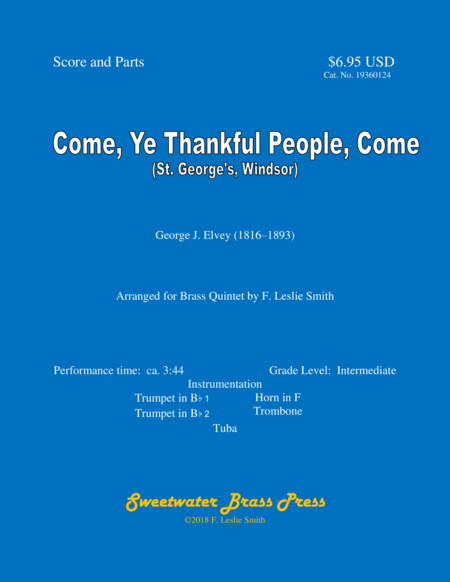Brass Ensemble - Digital Download SKU: A0.808697 Composed by George Job Elvey. Arranged by F. Leslie Smith. Christmas,Holiday. Score and parts. 28 pages. Sweetwater Brass Press #4999815. Published by Sweetwater Brass Press (A0.808697).   Henry Alford (1810–1871), Church of England cleric and man of many talents, wrote the words for Come, Ye Thankful People, Come in 1844. Fourteen years later, Alford’s hymn was set to a melody composed by George J. Elvey (1816–1893). Elvey had named the tune St. George’s, Windsor after the chapel in Windsor, England, where he was organist. The first verse of the hymn rejoices in the harvest and calls for celebrants to Come to God's own temple, come; raise the song of harvest home! As such, the hymn gained popularity in the United States as a celebration of Thanksgiving.  In keeping with the song’s celebratory and triumphal nature, this arrangement uses a fanfare as the recurring motif. The fanfare opens the piece, followed by a rejoicing, exultant first statement of the melody. In the second statement, the fanfare figure returns and forms the structure for the section. The third statement is styled as a kind of rondo; the fourth and last, grandioso. The fourth statement also changes key twice--F to B-flat, then to E-flat--includes a walking bass part and ends with, again, the fanfare. The piece should be played Allegro moderato, about 120 bpm, and there are no really tricky rhythmic figures. Most notes are well within the normal range of the five instruments-Trombone’s highest are a couple of high F notes; Trumpet 1, high A notes. So most players will have little or no trouble.   This arrangement was completed in 2019, and performance time runs about 3 minutes, 44 seconds. The arranger, Les Smith, will be happy to provide substitute parts (for example, treble clef baritone for trombone) at no charge; contact him directly at lessmith61@bellsouth.net. For more arrangements by Les, enter Sweetwater Brass Press (without the quotation marks) in the SheetMusicPlus search box. (Also, purchase of this piece entitles you to your choice of another of his arrangements at no charge; send a copy of your purchase receipt directly to him at lessmith61@bellsouth.net.)
